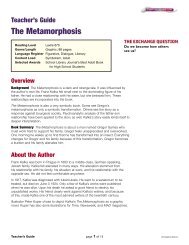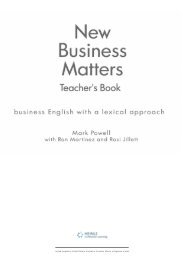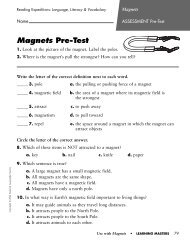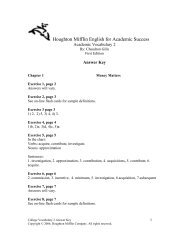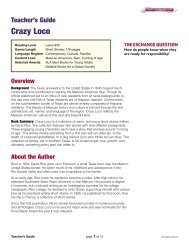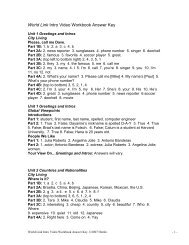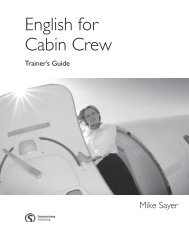Weaving It Together
Weaving It Together
Weaving It Together
Create successful ePaper yourself
Turn your PDF publications into a flip-book with our unique Google optimized e-Paper software.
To the Teacher<br />
Organization of the<br />
Student Book<br />
<strong>Weaving</strong> <strong>It</strong> <strong>Together</strong>, Book 3, has eight<br />
units. Each unit is divided into two chapters<br />
related to the unit theme. <strong>Weaving</strong> <strong>It</strong><br />
<strong>Together</strong>, Book 4, has nine chapters. Each<br />
chapter has two readings related to a single<br />
chapter theme. The themes have been carefully<br />
selected to appeal to a wide range of interests<br />
and to promote discussion and comparison of<br />
different cultures.<br />
The sequence of activities in each chapter<br />
follows this pattern:<br />
• What Do You Think? activity<br />
• Pre-reading and predicting activities<br />
• Reading<br />
• Vocabulary activities<br />
• Comprehension activities<br />
• Discussion and critical thinking questions<br />
• Writing skills<br />
• Writing practice activities<br />
Each step in the sequence is important to<br />
the fi nal goal of enabling students to produce<br />
excellent written English. All skills of reading,<br />
writing, generating ideas, and developing<br />
vocabulary are integrated throughout each<br />
chapter with the aim of achieving this goal.<br />
Grading of Written Work<br />
The criteria you choose for grading your<br />
students’ written work will vary according to<br />
the aims in your course description. In general,<br />
your students can be expected to hand in at<br />
least one preliminary draft of their work before<br />
handing in their fi nal draft. The process of<br />
re-writing and editing written work is<br />
4 To the Teacher<br />
consistently emphasized in this series. The<br />
editing tips at the end of each section will help<br />
students become effective editors of their own<br />
and each other’s work. <strong>It</strong> is also important to<br />
value original and thoughtful writing as well as<br />
the amount of effort invested in the work.<br />
Here are some suggestions for correcting<br />
students’ written work:<br />
• Use written correction symbols so that<br />
students have to fi nd their own mistakes<br />
(see page 13 for examples).<br />
• Make clear your criteria for grading<br />
written work. You may want to use the<br />
same criteria each time, or you may<br />
prefer to focus on specifi c points. You<br />
might focus on paragraph formatting for<br />
the fi rst assignment, for example, and<br />
then gradually add other criteria such<br />
as grammar, vocabulary, and content.<br />
See page 12 for possible writing rubrics,<br />
which may be adapted for your class.<br />
• Have students work in pairs to check<br />
their essays before handing them in. Peer<br />
editing is a great way to help students<br />
learn to become more independent.<br />
Encourage students to use the editing<br />
checklist at the end of each chapter in<br />
the student book when correcting each<br />
other’s work.<br />
• Remember that a page covered<br />
in corrections is going to be very<br />
discouraging for your students. If one<br />
mistake recurs frequently in an essay,<br />
correct it just once and ask the student<br />
to fi nd other examples of the mistake by<br />
himself or herself.<br />
• Remember to use a balance of both<br />
praise and criticism in your comments!<br />
00238-X_001-005.indd 4 14/12/09 2:07 PM



